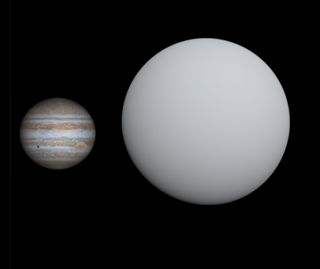Related Research Articles
The Hungarian Automated Telescope Network (HATNet) project is a network of six small fully automated "HAT" telescopes. The scientific goal of the project is to detect and characterize extrasolar planets using the transit method. This network is used also to find and follow bright variable stars. The network is maintained by the Center for Astrophysics | Harvard & Smithsonian.
The XO Project is an international team of amateur and professional astronomers tasked with identifying extrasolar planets. They are led by Peter R. McCullough of the Space Telescope Science Institute. It is primarily funded by NASA's Origins Program and the Director's Discretionary Fund of the Space Telescope Science Institute.

WASP-4b is an exoplanet, specifically a hot Jupiter, approximately 891 light-years away in the constellation of Phoenix.
HD 118203 is a star with an orbiting exoplanet located in the northern circumpolar constellation of Ursa Major. It has the proper name Liesma, which means flame, and it is the name of a character from the Latvian poem Staburags un Liesma. The name was selected in the NameExoWorlds campaign by Latvia, during the 100th anniversary of the IAU.
Qatar-5b is a Hot Jupiter orbiting the star Qatar-5 located in Andromeda constellation. It orbits its star every 2.87 days. It was discovered in 2016 by the Qatar Exoplanet Survey (QES).

XO-6b is a transiting exoplanet, a hot Jupiter, orbiting the star XO-6 around 760 light years away from Earth. It was discovered in 2016 by the XO planet search team.
WASP-79b, also known as Pollera, is an extrasolar planet orbiting the star CD-30 1812. This planet is in the constellation Eridanus, and is about 810 light-years from Earth.

WASP-107b is a super-Neptune exoplanet that orbits the star WASP-107. It lies 200 light-years away from Earth in the constellation Virgo. Its discovery was announced in 2017 by a team led by D. R. Anderson via the WASP-South.
Qatar-1 is an orange main sequence star in the constellation of Draco.
Qatar-2 is a K-type main-sequence star about 595 light-years away in the constellation of Virgo. The star is much older than Sun, and has a concentration of heavy elements similar to solar abundance. The star features a numerous and long-lived starspots, and belongs to a peculiar variety of inflated K-dwarfs with strong magnetic activity inhibiting internal convection.
Qatar-3 is a 12th magnitude star located in the northern constellation Andromeda. It is host to a transiting planet. With a radial velocity of 10.99 km/s, it is drifting away from the Solar System, and is currently located 2,400 light years away based on its annual parallax.
The Qatar Exoplanet Survey, also known as QES, is an international exoplanet search survey based in Qatar. Its main goal is to detect exoplanets using the transit method, which is observing the light curve of the host star.
Qatar-4 is a faint K-dwarf star that hosts a planet in the constellation Andromeda. With an apparent magnitude of 13.60, it is impossible to detect with the naked eye, but can be detected with a powerful telescope. Qatar-4 is currently located 1,083 light years away based on parallax.
References
- ↑ "Astronomers discover three 'Qatar' exoplanets".
- ↑ Hamer, Jacob H.; Schlaufman, Kevin C. (2019-11-01). "Hot Jupiters Are Destroyed by Tides While Their Host Stars Are on the Main Sequence". The Astronomical Journal. 158 (5): 190. arXiv: 1908.06998 . Bibcode:2019AJ....158..190H. doi: 10.3847/1538-3881/ab3c56 . ISSN 0004-6256. S2CID 201103951.
- ↑ Alsubai, Khalid; et al. (2017). "Qatar Exoplanet Survey: Qatar-3b, Qatar-4b, and Qatar-5b". The Astronomical Journal. 153 (4). 200. arXiv: 1606.06882 . Bibcode:2017AJ....153..200A. doi: 10.3847/1538-3881/aa6340 . S2CID 119214858.